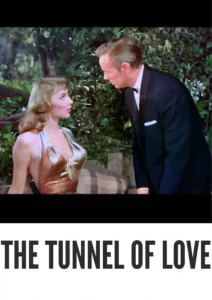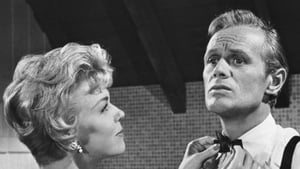Contact: info@alwanfilm.com
Video Sources 0 Views

Synopsis
Review: The Tunnel of Love 1958 Colorized – Navigating the Charms of an Early Colored Gem

Introduction
Welcome to the delightful world of The Tunnel of Love 1958, a romantic comedy that has recently been revitalized in an early colored version. In this article, we delve into the significance of this edition, exploring how colorization enhances the viewing experience and its broader implications in film history.
Check The Full Colorized Movies List
Check Our Colorized Movies Trailer Channel
Understanding The Tunnel of Love 1958 Colorized: Director, Cast, and Genre
Directed by Gene Kelly, The Tunnel of Love 1958 is a charming romantic comedy that captures the essence of love in all its whimsical glory. Starring Doris Day and Richard Widmark in the lead roles, the film boasts a stellar cast that brings its delightful characters to life. Kelly’s direction infuses the film with a sense of joy and nostalgia, making it a timeless classic for audiences of all ages. Genre-wise, The Tunnel of Love 1958 falls into the category of romantic comedy, with a lighthearted tone and witty humor that will leave viewers smiling from ear to ear.
Exploring the World of The Tunnel of Love 1958 Colorized: Plot and Characters
Set in suburban America, The Tunnel of Love 1958 follows the misadventures of a married couple, Isolde Poole (Doris Day) and Augie Poole (Richard Widmark), as they navigate the ups and downs of married life. When Augie decides they need a baby to complete their family, hilarity ensues as they encounter a series of comical obstacles on their journey to parenthood. Along the way, they encounter a colorful cast of characters, including their eccentric neighbors and a wacky fertility expert, all of whom add to the film’s delightful charm.
The Art of Film Colorization
Film colorization, the process of adding color to black-and-white footage, has been a subject of much debate in the film industry. While some purists argue that it detracts from the original artistic vision, others see it as a way to breathe new life into classic films and make them more accessible to modern audiences. The process has evolved significantly over the years, with advancements in technology allowing for more accurate color reproduction. However, the decision to colorize a film remains a controversial one, with strong opinions on both sides of the debate.
Early Colored Films: A Brief History
The concept of coloring films dates back to the early days of cinema, with hand-tinting techniques used to add color to individual frames. However, it wasn’t until the mid-20th century that color films became the norm, with the advent of Technicolor and other color processes. These early colored films revolutionized the industry, allowing filmmakers to explore new creative possibilities and capture the world in vibrant hues.
The Tunnel of Love 1958 and Its Early Colored Version
The decision to release The Tunnel of Love 1958 in a colorized format marks a departure from its original presentation. While some may argue that it alters the film’s intended aesthetic, others see it as an opportunity to introduce a classic film to a new generation of viewers. The early colored version of the film seeks to enhance the viewing experience, adding depth and dimension to the story while preserving its timeless charm.
The Debate Over Film Colorization
The debate over film colorization is a contentious one, with strong opinions on both sides of the argument. Proponents argue that it allows classic films to reach a wider audience and breathe new life into old favorites. However, detractors argue that it compromises the integrity of the original film and alters the director’s artistic vision. As technology continues to advance, the debate over film colorization shows no signs of abating.
Examining The Tunnel of Love 1958 as an Early Colored Film
As one of the first black-and-white films to receive the colorization treatment, The Tunnel of Love 1958 provides a unique opportunity to explore the impact of this technique on the viewing experience. While purists may argue that it alters the film’s original aesthetic, others may appreciate the added dimension and visual flair that colorization brings to the story. Ultimately, the success of colorization depends on its ability to enhance the film without overshadowing its original charm.
Influence and Legacy: The Tunnel of Love 1958 Colorized’s Impact on Cinema
Despite the controversy surrounding its colorized release, The Tunnel of Love 1958 remains a beloved classic that continues to entertain audiences around the world. Its timeless themes of love, marriage, and family resonate with viewers of all ages, making it a perennial favorite for generations. Moreover, the film’s early colored version opens up new possibilities for future audiences to experience its magic in a fresh and exciting way.
Director’s Cinematic Legacy: Beyond The Tunnel of Love 1958 Colorized
Gene Kelly’s contribution to cinema extends far beyond Inhe Tunnel of Love 1958, with a body of work that spans multiple genres and styles. From iconic musicals like Singin’ in the Rain to heartfelt dramas like An American in Paris, Kelly’s films have left an indelible mark on the world of cinema. His legacy serves as a testament to the power of storytelling and the enduring appeal of the silver screen.
Themes Explored in The Tunnel of Love 1958 Colorized
The Tunnel of Love 1958 explores a variety of themes, including love, marriage, and the complexities of human relationships. Through the characters of Isolde and Augie, the film offers a humorous yet poignant look at the challenges of married life, reminding viewers that true love conquers all. Its lighthearted tone and witty dialogue make it a joy to watch, while its timeless message resonates with audiences of all ages.
Reception and Controversy Surrounding The Tunnel of Love 1958 Colorized
Upon its release, The Tunnel of Love 1958 received positive reviews from critics and audiences alike, who praised its charming performances and witty screenplay. However, the decision to release the film in a colorized format sparked debate among cinephiles, with some embracing the change and others lamenting the loss of its original black-and-white aesthetic. Despite the controversy, the film’s enduring popularity has solidified its status as a beloved classic.
Where to Watch The Tunnel of Love 1958 Colorized Online
For those eager to experience the magic of The Tunnel of Love 1958, the film is readily available on popular streaming platforms such as Amazon Prime Video and iTunes. Whether you choose to watch it in its original black-and-white format or the early colored version, the film promises to enchant and delight audiences with its timeless charm and irresistible humor.
FAQs About The Tunnel of Love 1958 Colorized
Q: Is The Tunnel of Love 1958 based on a true story? A: No, The Tunnel of Love 1958 is a fictional story that explores the ups and downs of married life in a humorous and lighthearted manner.
Q: Who are the main actors in The Tunnel of Love 1958? A: The film stars Doris Day and Richard Widmark in the lead roles, with memorable performances from the supporting cast.
Q: What is the significance of the film’s early colored version? A: The early colored version of The Tunnel of Love 1958 offers a fresh perspective on the film, enhancing the visual experience while staying true to its original charm and humor.
Conclusion
As we conclude our exploration of The Tunnel of Love 1958, it becomes clear that the film’s enduring appeal transcends its colorization controversy. Whether viewed in its original black-and-white format or the early colored version, the film continues to captivate audiences with its timeless charm and irresistible humor. As viewers, we are reminded of the importance of preserving cinematic treasures like The Tunnel of Love 1958 and honoring the director’s artistic vision. In the end, it is not the color of the film that matters, but the depth of its storytelling and the joy it brings to audiences around the world.











